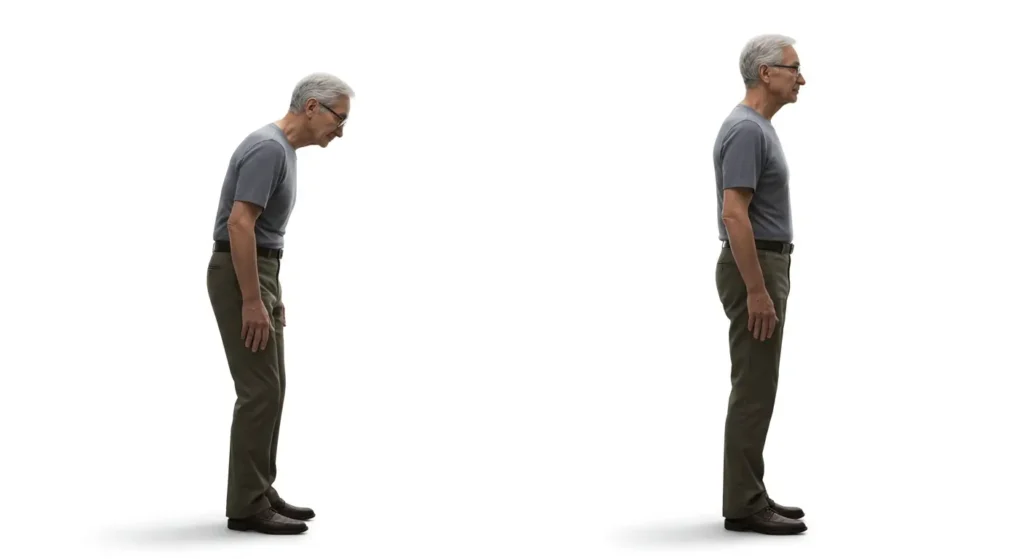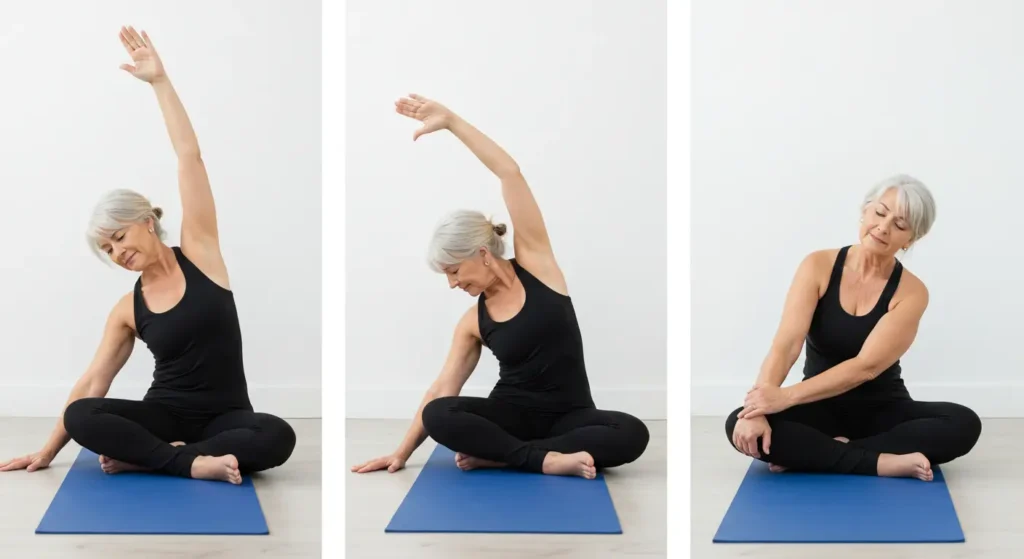
Why Neck and Shoulder Pain Is So Common After 60
Neck and shoulder pain can creep in slowly — a slight stiffness in the morning, a dull ache after reading or watching TV, or a tight feeling at the end of the day. For many adults over 60, this discomfort becomes so common that it feels “normal.”
But here’s the truth: it’s not just part of aging. These pains are often a sign that something deeper is happening — especially with your posture. The way you sit, stand, and even sleep can slowly pull your head and shoulders out of alignment, putting stress on your muscles and joints every single day.
The good news? You don’t need complicated treatments or expensive gadgets to feel relief. In fact, gentle, natural changes to your daily routine can make a real difference in how your neck and shoulders feel — and how you move through life.
In this article, you’ll discover simple, effective habits that can help reduce pain, improve posture, and restore comfort and mobility — naturally.
Understanding the Root Cause: It’s Often About Posture

Most people think neck and shoulder pain comes from “sleeping wrong” or “getting older.” But in reality, one of the biggest hidden causes is something we do every day — often without noticing:
Forward head posture.
This happens when the head leans forward in front of the shoulders instead of staying aligned over the spine. It might not seem like a big deal, but every inch your head moves forward adds extra pressure to your neck — sometimes up to 60 pounds of strain! Especially at night, using a supportive pillow designed to keep your neck aligned can reduce tension and improve sleep quality over time.
Over time, this imbalance puts constant tension on the muscles in your neck, shoulders, and upper back. It can lead to:
- Persistent tightness or soreness in the neck
- Burning or aching pain across the shoulders
- Stiffness when turning your head or looking down
- Even tension headaches or numbness in the arms
Postural problems like this don’t usually happen overnight — they build slowly from habits like looking down at a phone, reading in bed, or sitting for long periods with rounded shoulders.
The good news? Just as these habits created the problem, better habits can begin to reverse it.
The Hidden Effects of Forward Head Posture
You might think forward head posture only affects your neck — but its reach goes much further. When your head is out of alignment, your entire body has to compensate to keep you upright. That means your spine, shoulders, breathing, and even energy levels can be affected.
Over time, this imbalance can lead to issues such as:
- Rounded shoulders and a hunched upper back, making it harder to stand or walk tall
- Reduced lung capacity, because your chest can’t expand fully when your posture collapses forward
- Less blood flow to the brain, which may affect focus and increase fatigue
- Tension headaches that start in the neck and radiate to the temples or behind the eyes
For older adults, these effects are even more important. As we age, balance and mobility naturally decline — and poor posture can make those changes worse, increasing the risk of falls or joint problems.
That’s why correcting posture isn’t just about looking better. It’s about restoring function, confidence, and comfort in everyday life. In some cases, a lightweight posture corrector can help bring awareness to alignment and support better habits throughout the day.
Daily Habits That Make a Real Difference
Improving your posture and reducing neck and shoulder pain doesn’t require intense workouts or rigid routines. In fact, small adjustments done consistently can create big results over time. Here are some habits to begin incorporating into your day:
✅ 1. Start Your Day with Gentle Neck Mobility
Begin each morning with simple neck movements: slow side-to-side turns, gentle chin tucks, and shoulder rolls. These motions loosen up stiffness, improve blood flow, and send a signal to your body to reset posture.
✅ 2. Use a Wall to Check Alignment
Stand with your back against a wall — heels, buttocks, shoulders, and head gently touching it. This helps your body “remember” what good posture feels like. Do this for 1–2 minutes a few times a day.

✅ 3. Strengthen the Muscles That Support Your Neck
Certain muscles — like the deep cervical flexors and upper back stabilizers — weaken with age or inactivity. Targeted movements that gently strengthen these areas can restore balance and relieve pressure. Light resistance bands can be an excellent tool for performing these movements at home, especially for beginners.
✅ 4. End the Day with Light Stretching
Before bed, try slow shoulder stretches and a gentle doorway chest opener to release tightness from the day. This helps reset your posture while also calming tension before sleep. You can also use a small foam roller or massage tool to gently relax tense muscles in the neck and upper back.
You don’t need to do everything at once. Start with 1 or 2 habits and build gradually. The most important part is staying consistent — that’s what creates lasting change.
When to Take Action – And How to Start Gently
Many adults over 60 wait too long before addressing their neck and shoulder pain — often hoping it will pass on its own. But when discomfort becomes part of your daily life, it’s a sign that something needs to change.
Here are a few clear signals that it’s time to take action:
- You feel stiff or sore every morning, especially around the neck or upper back
- You struggle to turn your head or raise your arms comfortably
- Your shoulders feel tense, even when you’re resting
- You notice a forward tilt in your head or rounded shoulders in the mirror
The good news? Relief doesn’t have to mean drastic measures. You can begin with gentle movement, awareness, and a few minutes a day dedicated to improving posture and mobility.
What matters most is choosing a strategy that’s designed for your stage of life — one that respects your limits but helps you build strength, stability, and confidence little by little.
A Proven Solution to Reset Your Posture at Home

If you’ve been suffering from neck and shoulder pain for some time, you may have tried massages, medication or even stretching routines, but found that the relief never lasts long.This is usually because these approaches focus only on the symptoms – and not on the root cause: the postural imbalance itself. Fortunately, today there are affordable programs created by specialized health professionals that offer a more complete approach. They combine gentle corrective movements, clear explanations and easy-to-follow routines – all designed especially for people over 60. These solutions have helped thousands of people regain mobility and reduce pain, without relying on expensive treatments or complicated devices. Best of all: you can start at home, at your own pace, in complete safety. If you’re looking for a reliable starting point, consider getting to know one of these methods. It could be just what your body needs to regain alignment – and the freedom to move more comfortably.
Frequently Asked Questions
1- “Isn’t neck and shoulder pain just part of aging?”
Not necessarily. While some stiffness is common with age, chronic neck and shoulder pain often signals a deeper issue — usually related to posture and muscle imbalance. Many people feel lasting relief once they correct these patterns.
2- “I’ve tried stretching before and it didn’t help. What’s different now?”
Stretching alone may not solve the problem if the deeper cause — like forward head posture — isn’t addressed. A targeted approach that restores alignment and strengthens key muscles can make a much bigger difference.
3- “Can I really improve my posture after 60?”
Yes. The body is incredibly adaptive, even later in life. With the right guidance and consistent effort, it’s absolutely possible to improve posture, reduce pain, and feel more confident in your movements.
4- “How long until I feel a difference?”
Most people begin noticing improvements in posture and tension within a couple of weeks, especially when following a structured plan. Small changes, when done daily, add up quickly.
Small Daily Changes, Big Lifelong Results

Neck and shoulder pain can make even the simplest parts of your day feel harder — getting out of bed, reaching for something, or just relaxing without tension.
But you’re not stuck with this discomfort. With a better understanding of posture and a few consistent habits, you can retrain your body to move and feel better — even after 60.
You don’t need to be perfect. You just need to start.
And if you’d like a little extra help along the way, there are proven step-by-step methods built exactly for this stage of life — gentle, practical, and surprisingly effective.
✅ Want to try a safe and proven method at home?
💚 Discover a simple at-home strategy for better posture and less pain
🛑 Disclaimer
This article is for informational purposes only and does not constitute medical advice. Always consult your doctor or a qualified healthcare provider before starting any new exercise, posture correction routine, or health program — especially if you have a pre-existing condition or experience chronic pain. Results may vary based on individual health and consistency.
